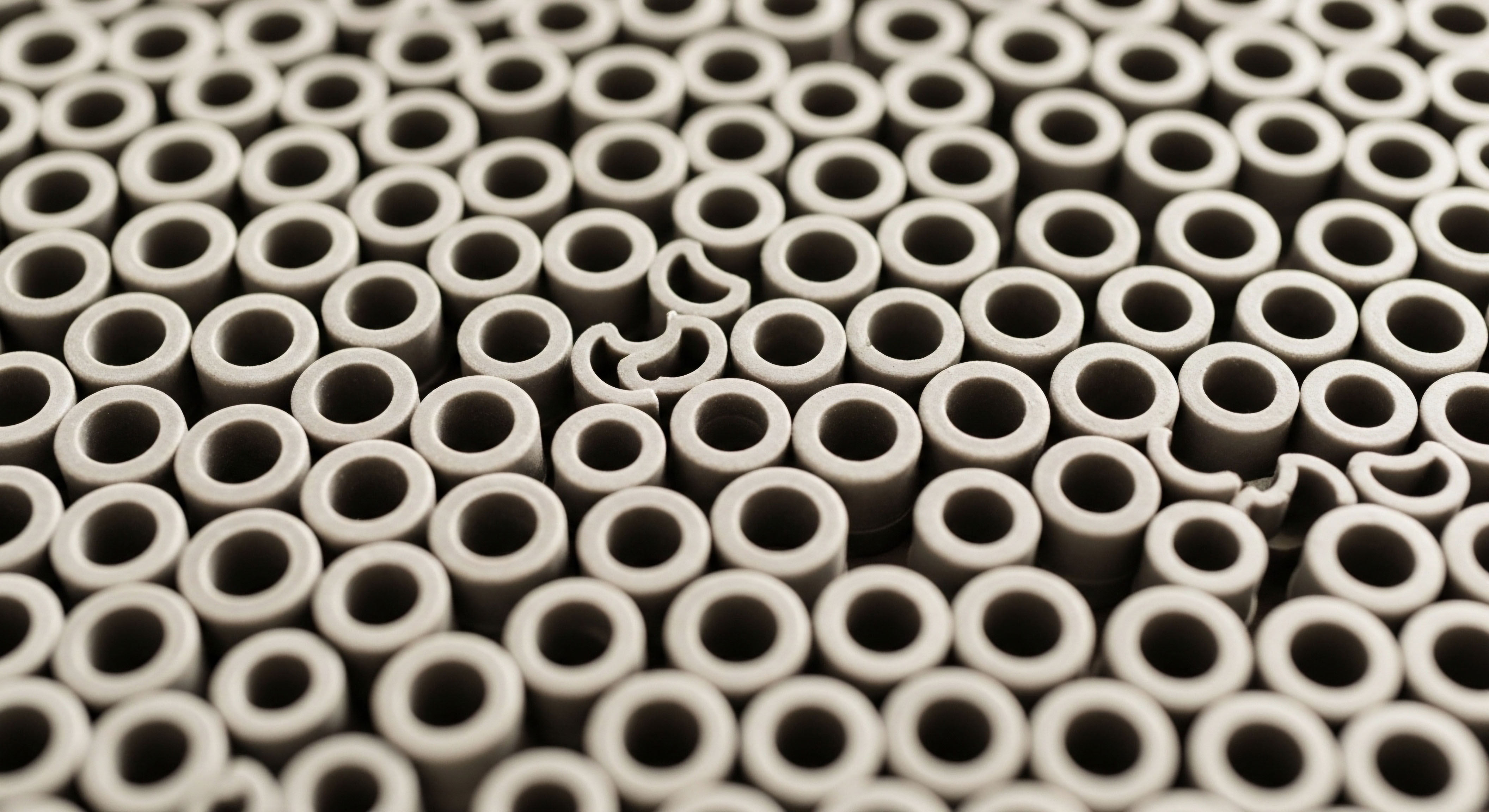

Fundamentals
Experiencing a decline in vitality, a diminishing spark, or a sense that your body is no longer responding as it once did can feel isolating. When discussions turn to intimate health, particularly erectile function, the silence often deepens. Many individuals find themselves grappling with these changes, often attributing them to age or an unavoidable decline.
Yet, this experience is not merely a personal struggle; it is a signal from your biological systems, indicating an imbalance that warrants attention. Understanding these signals, and the intricate biological systems that produce them, represents the first step toward reclaiming your physical and mental well-being.
Your body operates as a sophisticated network, with various systems communicating through a complex messaging service of hormones. When this internal communication falters, the effects can ripple across multiple aspects of your health, including sexual function. Testosterone, a primary male sex hormone, plays a central role in this communication network.
Its influence extends beyond libido and erectile quality, impacting muscle mass, bone density, mood, and cognitive clarity. When testosterone levels are suboptimal, the symptoms can manifest as reduced sexual desire, difficulty achieving or maintaining an erection, decreased muscle mass, increased body fat, and a general sense of fatigue.
Understanding your body’s signals is the initial step toward restoring vitality and function.

The Hormonal Blueprint
The production and regulation of testosterone are governed by a precise feedback system known as the Hypothalamic-Pituitary-Gonadal (HPG) axis. This axis functions like a finely tuned thermostat, constantly adjusting hormone levels to maintain equilibrium. The hypothalamus, a region in your brain, releases Gonadotropin-Releasing Hormone (GnRH).
This chemical messenger then signals the pituitary gland, situated at the base of your brain, to secrete two crucial hormones ∞ Luteinizing Hormone (LH) and Follicle-Stimulating Hormone (FSH). LH and FSH then travel to the testes, stimulating them to produce testosterone and sperm. When testosterone levels rise, they send a signal back to the hypothalamus and pituitary, dampening the release of GnRH, LH, and FSH, thus completing the feedback loop.
This intricate system ensures that testosterone levels remain within a healthy physiological range. Disruptions to any part of this axis can lead to imbalances, impacting overall health and specifically, erectile function. Lifestyle factors, often overlooked, exert a profound influence on the delicate balance of this axis. They can either support its optimal operation or contribute to its dysregulation.

What Is Erectile Function?
Erectile function represents a complex physiological process involving a coordinated interplay of the nervous, vascular, and hormonal systems. Achieving an erection requires sexual arousal, which triggers the release of chemical messengers, notably nitric oxide (NO), within the penile tissues. Nitric oxide acts as a vasodilator, relaxing the smooth muscle cells in the blood vessels of the penis.
This relaxation allows for a substantial increase in blood flow into the erectile chambers, known as the corpora cavernosa, causing them to engorge and stiffen. Simultaneously, this engorgement compresses the veins that drain blood from the penis, trapping the blood and maintaining rigidity.
Testosterone plays a direct role in this process by influencing the production of nitric oxide and maintaining the health and integrity of the penile tissues, including the smooth muscle and endothelial cells. Low testosterone levels can compromise this delicate mechanism, leading to reduced blood flow and impaired nerve sensitivity, making it challenging to achieve or sustain an erection. Therefore, supporting healthy testosterone levels is a foundational step in addressing concerns related to erectile function.


Intermediate
For individuals experiencing symptoms of low testosterone, such as diminished erectile function, Testosterone Replacement Therapy (TRT) offers a direct means of restoring hormonal balance. TRT involves supplementing the body with exogenous testosterone, aiming to bring serum levels into a physiological range.
While TRT can significantly improve symptoms, its efficacy, particularly for erectile function, can be greatly enhanced by concurrent lifestyle adjustments. These adjustments do not merely complement TRT; they actively participate in creating an internal environment conducive to optimal hormonal signaling and overall physiological responsiveness.
TRT’s effectiveness for erectile function improves significantly when combined with lifestyle adjustments.

Understanding TRT Protocols
A standard TRT protocol for men often involves weekly intramuscular injections of Testosterone Cypionate, typically at a concentration of 200mg/ml. This method provides a steady release of testosterone into the bloodstream. To address potential side effects and maintain broader endocrine health, TRT protocols frequently incorporate additional medications.
- Gonadorelin ∞ Administered via subcutaneous injections, often twice weekly, gonadorelin is a synthetic form of GnRH. Its purpose is to stimulate the pituitary gland to continue producing LH and FSH, thereby maintaining the testes’ natural function, including endogenous testosterone production and fertility. This helps mitigate testicular atrophy, a common side effect of exogenous testosterone administration, which can suppress the HPG axis.
- Anastrozole ∞ This oral tablet, typically taken twice weekly, functions as an aromatase inhibitor. Aromatase is an enzyme that converts testosterone into estrogen. While some estrogen is essential for male health, excessive conversion can lead to undesirable side effects such as gynecomastia or water retention. Anastrozole helps manage estrogen levels, ensuring they remain within a healthy range. However, careful monitoring of estrogen levels is important, as suppressing estrogen too much can also have negative health consequences.
- Enclomiphene ∞ In some protocols, enclomiphene may be included. This medication is a selective estrogen receptor modulator (SERM) that acts at the pituitary to stimulate LH and FSH release. Its inclusion aims to support the body’s intrinsic testosterone production, particularly for men concerned with fertility preservation. The effectiveness of enclomiphene when used concurrently with exogenous testosterone is a subject of ongoing discussion, as exogenous testosterone can strongly suppress the HPTA.

Lifestyle as a Modulator of TRT Efficacy
The body’s response to TRT is not solely dependent on the administered hormone; it is profoundly influenced by the physiological landscape in which the hormone operates. Lifestyle adjustments act as powerful modulators, shaping this landscape to enhance the benefits of TRT, particularly for erectile function.

Nutritional Strategies for Hormonal Support
Dietary choices directly impact metabolic health, inflammation, and the body’s capacity to synthesize and utilize hormones. A balanced dietary pattern, rich in micronutrients, supports overall endocrine function. For instance, adequate intake of zinc, vitamin D, and magnesium contributes to testosterone production and metabolic regulation.
These nutrients participate in enzymatic reactions and cellular processes that underpin hormonal synthesis and signaling. Consuming a diet that prioritizes whole, unprocessed foods, lean proteins, healthy fats, and a wide array of fruits and vegetables provides the necessary building blocks and cofactors for optimal physiological function.
Conversely, diets high in processed foods, refined sugars, and unhealthy fats can contribute to systemic inflammation and insulin resistance, conditions that negatively impact hormonal balance and vascular health, thereby impeding TRT’s effectiveness for erectile function.

The Role of Physical Activity
Regular physical activity, particularly a combination of strength training and cardiovascular exercise, exerts a beneficial influence on hormonal health and erectile function. Strength training stimulates muscle growth, which is metabolically active tissue that can improve insulin sensitivity and support testosterone levels.
Cardiovascular exercise, such as brisk walking, jogging, or cycling, improves endothelial function and blood flow throughout the body, including to the penile tissues. Improved vascular health is a direct contributor to better erectile quality. Studies indicate that consistent exercise can significantly improve sexual function, even in individuals experiencing erectile dysfunction. For men undergoing TRT, exercise can help maintain muscle mass and bone mineral density, which might otherwise be compromised during weight loss, and can further improve aerobic capacity.

Sleep Quality and Hormonal Rhythm
Sleep is not merely a period of rest; it is a critical phase for physiological repair and hormonal regulation. Testosterone production, for instance, occurs predominantly during deep sleep, particularly during the early stages of non-REM sleep. Chronic sleep deprivation or poor sleep quality can lead to measurable drops in testosterone levels and elevate stress hormones like cortisol.
This disruption to the body’s natural circadian rhythms can undermine the benefits of TRT. Prioritizing 7 to 9 hours of high-quality, uninterrupted sleep each night supports the body’s intrinsic capacity for hormonal synthesis and regulation, creating a more receptive environment for TRT to exert its effects.

Stress Management and Endocrine Balance
Chronic psychological stress activates the Hypothalamic-Pituitary-Adrenal (HPA) axis, leading to sustained elevation of cortisol, a stress hormone. The HPA axis and the HPG axis are interconnected; chronic cortisol elevation can suppress the HPG axis, negatively impacting testosterone production.
Even when exogenous testosterone is administered via TRT, persistent high stress levels can impede the body’s overall responsiveness and its ability to utilize hormones effectively. Techniques such as mindfulness, meditation, deep breathing exercises, and spending time in nature can help modulate the stress response, reducing cortisol levels and fostering a more balanced endocrine environment. Addressing stress is a crucial component of any personalized wellness protocol, as it influences not only hormonal health but also mental well-being and overall vitality.
The synergy between TRT and lifestyle adjustments creates a powerful approach to reclaiming vitality. While TRT addresses the direct hormonal deficiency, lifestyle interventions optimize the body’s internal systems, allowing the therapy to work with greater efficiency and deliver more comprehensive benefits.


Academic
The efficacy of Testosterone Replacement Therapy for erectile function extends beyond simply normalizing circulating testosterone levels. A deeper understanding requires examining the intricate molecular and cellular pathways influenced by testosterone and how lifestyle factors modulate these mechanisms. The human body functions as a highly integrated biological system, where the endocrine, metabolic, and neurological systems are in constant dialogue.
Erectile dysfunction, in this context, is not merely a localized vascular issue; it often reflects systemic dysregulation that lifestyle interventions can profoundly influence.
Erectile dysfunction often signals systemic dysregulation, which lifestyle interventions can significantly influence.

Molecular Mechanisms of Testosterone Action in Erectile Function
Testosterone exerts its effects on erectile function through multiple molecular pathways, acting both centrally within the nervous system and peripherally within penile tissues.

Nitric Oxide Signaling and Endothelial Health
The primary molecular pathway for penile erection involves the release of nitric oxide (NO) from nerve endings and endothelial cells in the corpus cavernosum. Nitric oxide activates guanylate cyclase, leading to an increase in cyclic guanosine monophosphate (cGMP), which in turn causes relaxation of cavernosal smooth muscle and subsequent vasodilation.
Testosterone plays a direct role in this pathway by influencing the expression and activity of nitric oxide synthase (NOS), the enzyme responsible for NO production. Studies indicate that adequate androgen levels are essential for the expression of the NOS gene within the penis. Low testosterone can lead to reduced NOS activity, compromising NO availability and impairing the vasodilatory response necessary for erection.
Beyond NO production, testosterone contributes to the structural and functional integrity of the penile endothelium. Endothelial dysfunction, characterized by impaired NO bioavailability and increased oxidative stress, is a common underlying factor in erectile dysfunction, particularly in conditions like diabetes and obesity. Testosterone helps maintain endothelial health, promoting a robust vascular response to sexual stimulation.

Smooth Muscle Physiology and Venous Occlusion
Erection also relies on the relaxation of cavernosal smooth muscle and the subsequent compression of venules, which traps blood within the penis. Testosterone influences the contractility and relaxation properties of these smooth muscle cells. Androgen deficiency can induce smooth muscle atrophy in the corpus cavernosum, potentially leading to venous leak, where blood escapes the penis prematurely, preventing sustained rigidity.
By maintaining the health and function of these smooth muscle cells, testosterone supports the veno-occlusive mechanism essential for a firm and lasting erection.

Interplay of Endocrine Axes and Metabolic Pathways
The HPG axis does not operate in isolation. It is intricately connected with other neuroendocrine systems, particularly the Hypothalamic-Pituitary-Adrenal (HPA) axis, which governs the stress response, and metabolic pathways that regulate energy balance and inflammation.
Chronic activation of the HPA axis, leading to sustained high levels of cortisol, can directly suppress the HPG axis at multiple levels, including the hypothalamus and pituitary. This suppression can reduce GnRH pulsatility and gonadotropin release, thereby lowering endogenous testosterone production.
Even with exogenous testosterone administration, persistent high cortisol levels can create a less responsive cellular environment, potentially diminishing the overall clinical benefits of TRT. This complex interplay highlights why stress management is not merely a psychological intervention but a physiological imperative for hormonal health.
Metabolic health, particularly insulin sensitivity and body composition, profoundly impacts testosterone levels and erectile function. Obesity, for instance, is associated with lower testosterone due to increased aromatase activity in adipose tissue, leading to greater conversion of testosterone to estrogen. Obesity also contributes to systemic inflammation and insulin resistance, which can directly impair endothelial function and nitric oxide signaling in the penis.
How Does Adipose Tissue Influence Testosterone Metabolism?
Adipose tissue, or body fat, is not merely an inert storage depot; it is an active endocrine organ. It produces various hormones and signaling molecules, including leptin and adiponectin, and contains significant amounts of the aromatase enzyme. Higher body fat percentage, especially visceral fat, correlates with increased aromatase activity, which converts testosterone into estradiol.
This increased conversion can lead to lower circulating testosterone and higher estrogen levels in men, contributing to symptoms of hypogonadism and potentially diminishing the effectiveness of TRT. Weight loss, therefore, reduces aromatase activity, helping to optimize the testosterone-to-estrogen ratio and enhancing the body’s response to TRT.
Can Gut Microbiota Affect Hormonal Balance and Erectile Function?
Emerging research suggests a connection between gut microbiota composition and hormonal balance, including the HPG axis. The gut microbiota produces various metabolites, some of which can influence host physiology, including endocrine function and inflammation. Dysbiosis, an imbalance in gut bacteria, can contribute to systemic inflammation and metabolic dysfunction, which in turn can negatively impact testosterone levels and endothelial health, indirectly affecting erectile function.
While direct causal links are still being elucidated, maintaining a diverse and healthy gut microbiome through dietary fiber and fermented foods may offer an additional avenue for supporting hormonal and vascular health.

Advanced Therapeutic Considerations and Peptide Science
Beyond traditional TRT, advanced protocols incorporate specific peptides to address nuanced aspects of hormonal health and sexual function.

Gonadorelin and HPG Axis Recalibration
As discussed, Gonadorelin, a synthetic GnRH analog, is employed to stimulate the pituitary’s release of LH and FSH. This stimulation helps preserve testicular size and function, which can be suppressed by exogenous testosterone. For men on TRT, maintaining testicular function is important for long-term testicular health and fertility potential. Gonadorelin offers a means to keep the HPG axis engaged, preventing complete shutdown and potentially facilitating easier recovery of natural testosterone production if TRT is discontinued.

Targeted Peptides for Sexual Health
Peptide therapy represents a frontier in personalized wellness, offering targeted interventions for specific physiological processes. PT-141 (Bremelanotide) is a notable example in the realm of sexual health. Unlike traditional erectile dysfunction medications that primarily act on blood flow, PT-141 works centrally by activating melanocortin receptors (MC3R and MC4R) in the brain, particularly in the hypothalamus. This central action stimulates sexual arousal and desire, leading to a more natural physiological response.
PT-141’s mechanism involves increasing the release of dopamine in brain regions associated with sexual desire. This makes it a compelling option for individuals whose erectile dysfunction has a significant psychological component or those who do not respond adequately to blood flow-enhancing medications. It can also be used synergistically with PDE-5 inhibitors, potentially enhancing the overall erectile response.
How Do Central Acting Peptides Influence Erectile Response?
Central acting peptides, such as PT-141, influence erectile response by modulating neural pathways involved in sexual arousal and desire. Instead of directly affecting penile blood vessels, these peptides stimulate specific receptors in the brain, leading to a cascade of neurological signals that initiate the physiological processes of erection.
This upstream action means that the body’s own arousal signals are amplified, creating a more integrated and complete sexual response. This approach is particularly valuable when the underlying issue is not solely vascular but involves a component of diminished desire or central nervous system signaling.
The integration of TRT with targeted lifestyle interventions and advanced peptide therapies represents a sophisticated approach to restoring not only erectile function but also overall vitality and well-being. This comprehensive strategy acknowledges the complex interconnectedness of biological systems, offering a path toward sustained health and optimal function.
| Lifestyle Factor | Mechanism of Influence | Impact on TRT Efficacy for Erectile Function |
|---|---|---|
| Nutrition | Provides micronutrients (zinc, vitamin D), reduces inflammation, improves insulin sensitivity. | Enhances hormonal synthesis, supports endothelial health, improves cellular responsiveness to testosterone. |
| Exercise | Improves cardiovascular health, increases muscle mass, reduces body fat, enhances blood flow. | Optimizes vascular function, reduces aromatase activity, supports nitric oxide production, improves penile blood flow. |
| Sleep Quality | Supports endogenous testosterone production, regulates stress hormones. | Maintains natural hormonal rhythms, reduces cortisol, creates a more favorable endocrine environment for TRT. |
| Stress Management | Reduces cortisol levels, modulates HPA axis activity. | Minimizes HPG axis suppression, improves overall physiological responsiveness to TRT. |
| Weight Management | Reduces adipose tissue, decreases aromatase activity, improves metabolic markers. | Optimizes testosterone-to-estrogen ratio, reduces systemic inflammation, enhances vascular health. |
| Medication | Primary Action | Role in TRT Protocol |
|---|---|---|
| Testosterone Cypionate | Exogenous testosterone replacement | Restores circulating testosterone levels to physiological range. |
| Gonadorelin | Stimulates GnRH receptors in pituitary | Maintains LH/FSH production, preserves testicular function and fertility. |
| Anastrozole | Aromatase inhibitor | Reduces conversion of testosterone to estrogen, manages estrogen levels. |
| Enclomiphene | Selective Estrogen Receptor Modulator (SERM) | Stimulates LH/FSH release from pituitary, supports endogenous testosterone production (often for fertility). |
| PT-141 (Bremelanotide) | Melanocortin receptor agonist (central action) | Stimulates sexual arousal and desire in the brain, can induce erections. |

References
- Traish, A. M. & Guay, A. T. (2009). Testosterone and erectile physiology. International Journal of Impotence Research, 21(1), 1-10.
- Yafi, F. A. Sharlip, I. D. & Becher, E. F. (2016). Testosterone replacement therapy and erectile dysfunction. International Journal of Impotence Research, 28(1), 1-6.
- Celik, O. & Yücel, S. (2013). Testosterone Replacement Therapy ∞ Should It Be Performed in Erectile Dysfunction?. Nephro-Urology Monthly, 5(4), 858-861.
- Kumar, P. & Singh, R. (2015). The Role of HPG Axis in Human Physiology. Journal of Clinical Endocrinology & Metabolism, 100(9), 3245-3254.
- Morgan, C. & Rance, J. (2019). Emerging insights into Hypothalamic-pituitary-gonadal (HPG) axis regulation and interaction with stress signaling. Frontiers in Endocrinology, 10, 567.
- Corona, G. Rastrelli, G. & Maggi, M. (2017). Testosterone and erectile dysfunction ∞ a systematic review and meta-analysis. Journal of Sexual Medicine, 14(11), 1335-1351.
- Miner, M. M. & Khera, M. (2015). Testosterone and the cardiovascular system. American Journal of Cardiology, 116(9), 1459-1464.
- Shigehara, K. et al. (2019). Predictive Factors of Efficacy Maintenance after Testosterone Treatment Cessation. Journal of Clinical Medicine, 8(2), 232.
- Khera, M. et al. (2014). The effect of testosterone replacement therapy on prostate-specific antigen (PSA) levels in men with hypogonadism ∞ a systematic review and meta-analysis. European Urology, 65(1), 15-23.
- Traish, A. M. et al. (2011). The dark side of testosterone deficiency ∞ II. Type 2 diabetes and metabolic syndrome. Journal of Andrology, 32(1), 11-22.

Reflection
Your personal health journey is a unique expression of your biological systems in action. The knowledge shared here about hormonal health, metabolic function, and personalized wellness protocols is not merely information; it is a lens through which you can begin to understand your own body’s intricate language.
Recognizing the signals your body sends, whether they manifest as changes in vitality or erectile function, represents an invitation to engage with your physiology on a deeper level. This understanding empowers you to move beyond simply addressing symptoms, allowing you to recalibrate your internal systems for sustained well-being.
Reclaiming vitality and function without compromise involves a partnership between clinical science and your daily choices. The insights gained from exploring the interconnectedness of your endocrine system and its impact on overall health serve as a foundation. Your path toward optimal health is a continuous process of learning, adapting, and aligning your lifestyle with your biological needs. This journey is deeply personal, requiring thoughtful consideration and guidance tailored to your unique physiological blueprint.



